C
Cr122
Guest
Posted by Rafael at Friday, September 30, 2011
Week four brings Dallas' defense's biggest challenge to date, a matchup against a young, talented and confident Detroit Lions offense which is averaging over 33 points per game, good for 4th in the league.
Offensive coordinator Scott Linehan has several skill position weapons which present problems for any defense, and whose tendencies will remind Cowboys fans a lot of their own offense. There are some favorite tactics Rob Ryan's guys will have to contain to get a win.
Keep Jahvid Best between the tackles
The 2nd year back is a smallish version of Felix Jones (5'9'', 190 lbs) and the Lions use him the same way. They want to put the ball in his hands -- he's averaged 21 touches per game thus far -- on perimeter runs, on short outlet passes and on screens. He's explosiveness and shake, but he's not built to take those touches inside. Detroit wants to run him to the perimeter, much as Washington tried with Tim Hightower, but the Lions do it in a slightly different way. Here's one heavy look the Lions threw at Tampa Bay:
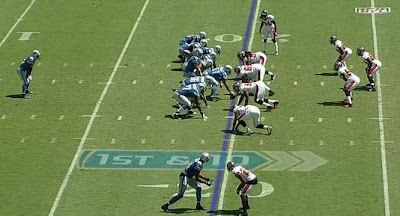
It's the 13 set, with Best in the backfield, Calvin Johnson as the lone receiver and all three tight ends to the left, in an overshifted formation. From two and three tight end sets, and from their preferred ace three WR set, Detroit uses a lot of pulling and misdirection to lure linebackers into false initial steps, to give Best a cutback lane:
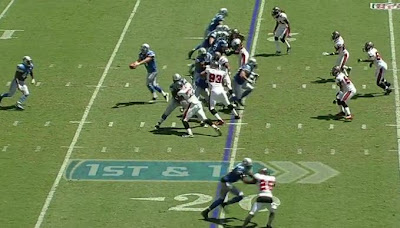
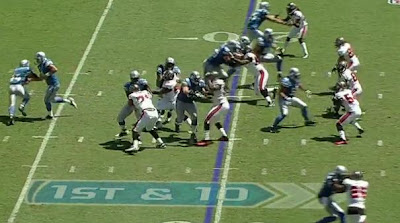
It's our old friend bend left. Best and Matthew Stafford tease a run right, to get the linebackers moving that way, before Best bends his run back towards the TE mass, who now have better cut-off blocking lanes This play popped for nine yards.
Detroit alternates these heavy looks with a three wideout set. Linehan uses a lot of slot receiver motion to curb backside defensive pursuit and help zone edge calls for Best work better. Here's an example from that same game. The Lions are three wide, with Nate Burleson in the right slot. Before the snap, he motions to the formation's left:

The play has two options. Look to Matthew Stafford's immediate right and you'll see Best, who faked the initial handoff. The TE pulling left gives the impression that the plays real purpose is a reverse left to Burleson. The Bucs middle linebacker and the right end both buy it. Look at them selling out to cut off Burleson's outside lane.
He's not the target. After faking to Burleson, Stafford rolls right and goes back to Best, who has released for a screen. With Burleson peeling his pursuit away, he's got lot of interference and room:
The Lions will run this reverse/fake reverse game with Burleson and third WR Titus Young, and the Cowboys have to figure out which permutation is being called. Is the play a stretch run to Best? Might it be a true reverse to the slot man? Might it be the third option screen?
Vertical to the Horizontal
Best's sideline-to-sideline short running and passing game can stretch a defense's front seven horizontally, setting it up for vertical passes to super wideout Calvin Johnson and Detroit's TE duo of Brandon Pettegrew and Tony Scheffler. Both of those big guys can get up the seams, and QB Matthew Stafford has been masterful at getting them the ball. He has shown great patience in the pocket this year, and has a great deep touch.
Stafford and the tight ends will challenge the Cowboys safeties, who have been effective at keeping balls in front of them. This week, they'll have to make sure the Lions don't lure them into a trap, as they did to Kansas City two weeks ago:
Here's Detroit in their three TE heavy set again. This brings nine Chiefs defenders into the box, and they shift towards the power on the right. Is this another stretch play or bend action to the TE side? Just before the snap, the third TE motions into an off-set I on the left side, to give the formation some balance. The motion still leaves Pettegrew and Scheffler on the right side. Kansas City keeps their players tight, expecting a run. The lone deep safety is on his right hash mark, giving some protection against a deep Calvin Johnson route:
The call is a play action pass, with Detroit going to max protection, sending just two men out on routes. Johnson goes deep up the left side, pulling the free safety with him. Scheffler gets a free release and runs up the right seam. The Chiefs corner on his side has to close and cover him. His coverage isn't bad, but Stafford makes a very accurate throw beyond his reach. When Scheffler grabs it, he's a couple of steps from a score. The FS tries to recover off his support on Johnson, but he has too much ground to make up:
There's a logic similar to the Eagles attack in Detroit's approach. Work the defense short and wide, get it thinking left-to-right and right-to-left, then strike over the top. It's been very effective so far.
How do you stop it, or at the very least slow it?
Take away the 7 step drops
This is a bit of a misnomer, since Detroit works Stafford from the shotgun a lot. The point is to pressure Stafford to keep him from running the deeper, slower developing routes he would throw off seven-step drops from under center. The Bucs and Chiefs did not sack Stafford in weeks one and two, and he built some gaudy stats. Last week, the Vikings stumped Stafford for a half,sacking him three times while limiting Detroit to just under 60 total yards. Right end Jared Allen bagged him twice and left end Brian Robison got the third. The two combined for five sacks over the 60 minutes.
They attacked the weaknesses on Detroit's line, the two offensive tackles. Right tackle Gosder Cherilus is stiff and has some trouble with edge speed. Left tackle Jeff Backus is a gritty old vet, but he can be overpowered. Here's a sequence from the Kansas City game where the Chiefs pressured Stafford into an interception with a three-man rush:
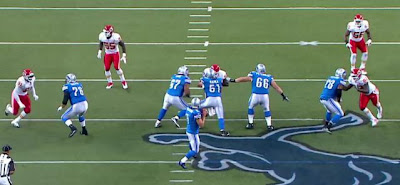
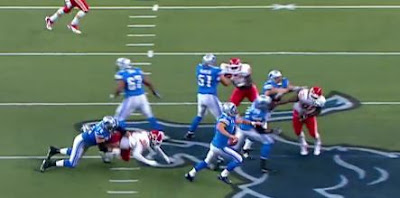
Backus is beaten by an inside counter move, while Tamba Hali walks Cherilus back into Stafford's path:

Rob Ryan has flopped his ends a lot the last couple of weeks, putting Demarcus Ware over right tackles and I think he'll do the same this week, getting his 5-sack man against Cherilus as often as possible. The key here is that Detroit can be pressured without heavy blitzing. Much of Minnesota's pressure came off four-man games. Dallas had success in its second half comeback rushing from base four and three-man looks, which let it stack the secondary.
Ryan will face his toughest set of skill position options this week, and if his front can get to Stafford quickly, he'll have to throw shorter routes and check-downs. The Vikings were very good at this, and might have held on, had their offense done a better job of moving the ball in the 2nd half. Here's a simple edge stunt that created a turnover:

Simple four-man pressure. The RB Best checks for a blitz and releases up the middle when he sees none. This leaves Allen (69) and the DT on his side two-on-two versus LT Backus and LG Rob Sims. The DT pushes his rush at Backus' inside shoulder, while Allen cuts underneath him:

Sims fails to hand off his man and switch to Allen. His QB gets drilled and fumbles:
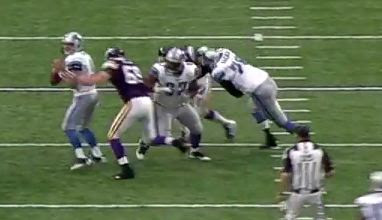
Last week's game turned on the ability of Ware, Anthony Spencer, Jay Ratliff and Victor Butler to pressure Rex Grossman on their own. If they can do this again, they have a real chance against Detroit's line, and the secondary gets a huge boost. The Lions want to spread the field and attack the intermediate and deep middle, to give Johnson room to work alone on the outside. Linehan wants to send five men on routes as often as possible, and trust his line to keep Stafford clean.
Heavy pressure will keep Best in the backfield as a blocker, eliminating one of Detroit's down-field options. Or, it will keep Detroit in more balanced and heavy sets.
Can Dallas contain Best's runs and pressure Stafford with four? It has been very effective at both tasks thus far. If it can, it can keep the safeties deep and play man-to-man in front of them. This would make Detroit's lion-like offense behave like a more domesticated cat.
Week four brings Dallas' defense's biggest challenge to date, a matchup against a young, talented and confident Detroit Lions offense which is averaging over 33 points per game, good for 4th in the league.
Offensive coordinator Scott Linehan has several skill position weapons which present problems for any defense, and whose tendencies will remind Cowboys fans a lot of their own offense. There are some favorite tactics Rob Ryan's guys will have to contain to get a win.
Keep Jahvid Best between the tackles
The 2nd year back is a smallish version of Felix Jones (5'9'', 190 lbs) and the Lions use him the same way. They want to put the ball in his hands -- he's averaged 21 touches per game thus far -- on perimeter runs, on short outlet passes and on screens. He's explosiveness and shake, but he's not built to take those touches inside. Detroit wants to run him to the perimeter, much as Washington tried with Tim Hightower, but the Lions do it in a slightly different way. Here's one heavy look the Lions threw at Tampa Bay:
It's the 13 set, with Best in the backfield, Calvin Johnson as the lone receiver and all three tight ends to the left, in an overshifted formation. From two and three tight end sets, and from their preferred ace three WR set, Detroit uses a lot of pulling and misdirection to lure linebackers into false initial steps, to give Best a cutback lane:
It's our old friend bend left. Best and Matthew Stafford tease a run right, to get the linebackers moving that way, before Best bends his run back towards the TE mass, who now have better cut-off blocking lanes This play popped for nine yards.
Detroit alternates these heavy looks with a three wideout set. Linehan uses a lot of slot receiver motion to curb backside defensive pursuit and help zone edge calls for Best work better. Here's an example from that same game. The Lions are three wide, with Nate Burleson in the right slot. Before the snap, he motions to the formation's left:
The play has two options. Look to Matthew Stafford's immediate right and you'll see Best, who faked the initial handoff. The TE pulling left gives the impression that the plays real purpose is a reverse left to Burleson. The Bucs middle linebacker and the right end both buy it. Look at them selling out to cut off Burleson's outside lane.
He's not the target. After faking to Burleson, Stafford rolls right and goes back to Best, who has released for a screen. With Burleson peeling his pursuit away, he's got lot of interference and room:
The Lions will run this reverse/fake reverse game with Burleson and third WR Titus Young, and the Cowboys have to figure out which permutation is being called. Is the play a stretch run to Best? Might it be a true reverse to the slot man? Might it be the third option screen?
Vertical to the Horizontal
Best's sideline-to-sideline short running and passing game can stretch a defense's front seven horizontally, setting it up for vertical passes to super wideout Calvin Johnson and Detroit's TE duo of Brandon Pettegrew and Tony Scheffler. Both of those big guys can get up the seams, and QB Matthew Stafford has been masterful at getting them the ball. He has shown great patience in the pocket this year, and has a great deep touch.
Stafford and the tight ends will challenge the Cowboys safeties, who have been effective at keeping balls in front of them. This week, they'll have to make sure the Lions don't lure them into a trap, as they did to Kansas City two weeks ago:
Here's Detroit in their three TE heavy set again. This brings nine Chiefs defenders into the box, and they shift towards the power on the right. Is this another stretch play or bend action to the TE side? Just before the snap, the third TE motions into an off-set I on the left side, to give the formation some balance. The motion still leaves Pettegrew and Scheffler on the right side. Kansas City keeps their players tight, expecting a run. The lone deep safety is on his right hash mark, giving some protection against a deep Calvin Johnson route:
The call is a play action pass, with Detroit going to max protection, sending just two men out on routes. Johnson goes deep up the left side, pulling the free safety with him. Scheffler gets a free release and runs up the right seam. The Chiefs corner on his side has to close and cover him. His coverage isn't bad, but Stafford makes a very accurate throw beyond his reach. When Scheffler grabs it, he's a couple of steps from a score. The FS tries to recover off his support on Johnson, but he has too much ground to make up:
There's a logic similar to the Eagles attack in Detroit's approach. Work the defense short and wide, get it thinking left-to-right and right-to-left, then strike over the top. It's been very effective so far.
How do you stop it, or at the very least slow it?
Take away the 7 step drops
This is a bit of a misnomer, since Detroit works Stafford from the shotgun a lot. The point is to pressure Stafford to keep him from running the deeper, slower developing routes he would throw off seven-step drops from under center. The Bucs and Chiefs did not sack Stafford in weeks one and two, and he built some gaudy stats. Last week, the Vikings stumped Stafford for a half,sacking him three times while limiting Detroit to just under 60 total yards. Right end Jared Allen bagged him twice and left end Brian Robison got the third. The two combined for five sacks over the 60 minutes.
They attacked the weaknesses on Detroit's line, the two offensive tackles. Right tackle Gosder Cherilus is stiff and has some trouble with edge speed. Left tackle Jeff Backus is a gritty old vet, but he can be overpowered. Here's a sequence from the Kansas City game where the Chiefs pressured Stafford into an interception with a three-man rush:
Backus is beaten by an inside counter move, while Tamba Hali walks Cherilus back into Stafford's path:
Rob Ryan has flopped his ends a lot the last couple of weeks, putting Demarcus Ware over right tackles and I think he'll do the same this week, getting his 5-sack man against Cherilus as often as possible. The key here is that Detroit can be pressured without heavy blitzing. Much of Minnesota's pressure came off four-man games. Dallas had success in its second half comeback rushing from base four and three-man looks, which let it stack the secondary.
Ryan will face his toughest set of skill position options this week, and if his front can get to Stafford quickly, he'll have to throw shorter routes and check-downs. The Vikings were very good at this, and might have held on, had their offense done a better job of moving the ball in the 2nd half. Here's a simple edge stunt that created a turnover:
Simple four-man pressure. The RB Best checks for a blitz and releases up the middle when he sees none. This leaves Allen (69) and the DT on his side two-on-two versus LT Backus and LG Rob Sims. The DT pushes his rush at Backus' inside shoulder, while Allen cuts underneath him:
Sims fails to hand off his man and switch to Allen. His QB gets drilled and fumbles:
Last week's game turned on the ability of Ware, Anthony Spencer, Jay Ratliff and Victor Butler to pressure Rex Grossman on their own. If they can do this again, they have a real chance against Detroit's line, and the secondary gets a huge boost. The Lions want to spread the field and attack the intermediate and deep middle, to give Johnson room to work alone on the outside. Linehan wants to send five men on routes as often as possible, and trust his line to keep Stafford clean.
Heavy pressure will keep Best in the backfield as a blocker, eliminating one of Detroit's down-field options. Or, it will keep Detroit in more balanced and heavy sets.
Can Dallas contain Best's runs and pressure Stafford with four? It has been very effective at both tasks thus far. If it can, it can keep the safeties deep and play man-to-man in front of them. This would make Detroit's lion-like offense behave like a more domesticated cat.
